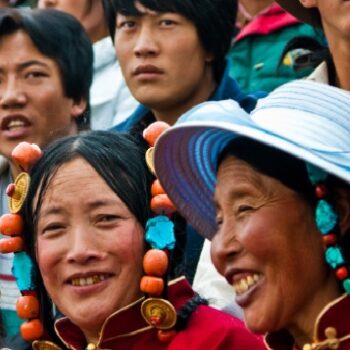Grade Level(s):
- 9-12
- 13-16
Source:
- Smithsonian National Museum of Natural History
Resource type:
- Classroom activity
Time: Eight 50-minute class periods
Overview
In this set of sequenced lessons, students learn how to devise an experiment to test the difference between acclimation and adaptation; investigate how scientific arguments show support for natural selection in Tibetans; design an investigation using a simulation based on the Hardy-Weinberg principle to explore mechanisms of evolution; and devise a test for whether other groups of people have adapted to living at high altitudes.

- [History of life: Grades 9-12] Present-day species evolved from earlier species; the relatedness of organisms is the result of common ancestry. (LS4.A)
- [History of life: Grades 9-12] Biological evolution accounts for diversity over long periods of time. (LS4.A, LS4.D)
- [Evidence of evolution: Grades 9-12] An organism's features reflect its evolutionary history.
- [Evidence of evolution: Grades 9-12] There is a fit between organisms and their environments, though not always a perfect fit. (LS4.C)
- [Mechanisms of evolution: Grades 9-12] There is variation within a population. (LS3.B)
- [Mechanisms of evolution: Grades 9-12] Natural selection acts on the variation that exists in a population. (LS4.B, LS4.C)
- [Mechanisms of evolution: Grades 9-12] Natural selection acts on phenotype as an expression of genotype.
- [Mechanisms of evolution: Grades 9-12] Organisms cannot intentionally produce adaptive mutations in response to environmental influences.
- [Mechanisms of evolution: Grades 9-12] Inherited characteristics affect the likelihood of an organism's survival and reproduction. (LS4.B, LS4.C)
- [Mechanisms of evolution: Grades 9-12] Traits that confer an advantage may persist in the population and are called adaptations. (LS4.B, LS4.C)
- [Mechanisms of evolution: Grades 9-12] Natural selection is dependent on environmental conditions.
- [Mechanisms of evolution: Grades 9-12] Over time, the proportion of individuals with advantageous characteristics may increase due to their likelihood of surviving and reproducing. (LS4.B, LS4.C)
- [Mechanisms of evolution: Grades 9-12] Random factors can affect the survival of individuals and of populations.
- [Nature of science: Grades 9-12] A hallmark of science is exposing ideas to testing. (P3, P4, P6, P7)
- [Nature of science: Grades 9-12] Scientists test their ideas using multiple lines of evidence. (P6, NOS2)
- [Nature of science: Grades 9-12] Scientists use multiple research methods (experiments, observational research, comparative research, and modeling) to collect data. (P2, P3, P4, NOS1)
- [Nature of science: Grades 9-12] Scientists can test ideas about events and processes long past, very distant, and not directly observable.
- [Studying evolution: Grades 9-12] Scientists use experimental evidence to study evolutionary processes.
- Disciplinary Core Idea LS4.A: Evidence of Common Ancestry and Diversity
- Disciplinary Core Idea LS3.B: Variation of Traits
- Disciplinary Core Idea LS4.B: Natural Selection
- Disciplinary Core Idea LS4.C: Adaptation
- Disciplinary Core Idea LS4.D: Biodiversity and Humans
- NOS Matrix understanding category 1. Scientific investigations use a variety of methods.
- NOS Matrix understanding category 2. Scientific knowledge is based on empirical evidence.
- Science and Engineering Practice 4. Analyzing and interpreting data
- Science and Engineering Practice 6. Constructing explanations and designing solutions
- Science and Engineering Practice 7. Engaging in argument from evidence
Grades 9-12: High school teachers may want to pick and choose selected lessons within this sequence to use. Some lessons may be too challenging for a regular high school biology course. The more challenging lessons could be particularly useful in an AP biology course.
Grades 13-16: These lessons were developed for AP biology students, but the level of the material is appropriate for college students.
